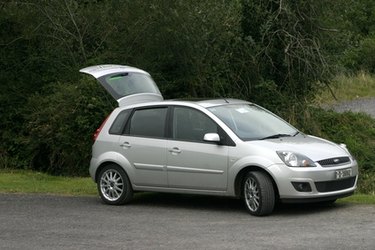
All engines at one time or another will have idle problems; Ford engines can have idle stumbling, surges and stall-outs, no matter what make and year. Engines should run smooth and evenly when at idle, never fluctuating in rpm or dying. Such symptoms have to be checked out, determining which vehicle components might be at fault through a process of elimination. Some obvious culprits of rough engine idle should be checked out before other systems. The average vehicle owner can find and repair such problems by knowing what circuits and components control the idle quality.
PCV Valve
Check the positive crankcase ventilation (PCV) valve on your vehicle. On vehicles equipped with it, it will be located on the top of the valve cover. The PCV valve resembles a small tube that attaches to a hose. The tube-like valve has a small check-ball inside that opens and closes off the intake manifold vacuum. Remove the valve and spray carburetor inside of it and shake it vigorously. Once you hear the "clacking" noise of the ball, plug it back into the hose and connect it to the valve cover opening. Check the vacuum line at both sides to make sure they have tight fits, with no leaks.
EGR Valve
Locate the exhaust gas return (EGR) valve on the vehicle. It looks like a diaphragm about the size of a fist and will be located next to the throttle body, connected to the PCV valve. The EGR valve should be closed when the engine idles, but if it sticks, it will cause an uneven idle and worsen the gas mileage. The EGR valve monitors the flow of exhaust gases to the intake manifold and should gradually warm up during normal engine operation. If the EGR valve gets too hot to the touch right after engine start-up, it means that it has stuck in the open position. Replace the EGR valve.
Fuel Injectors
Use an ohm meter to check your fuel injectors (with the engine running), by removing the wire from the injector. Two metal prongs sit inside the connector. Set the meter for the ohm setting. Touch the red meter lead to one contact and the black lead to the other prong. The ohm resistance number should be the about the same for all the injectors. If any injector reading shows a higher or lower than average number, the cause will be a defective injector, which will cause a rough idle. A zero reading will indicate a shorted injector, and must be replaced. You can also use a stethoscope or a long handled screwdriver to place on the injector head. You should be able to hear a clicking sound, telling you that the injector is "pulsing." No clicking sound indicates a dead injector.
Carburetor-Equipped Vehicles
Examine the choke setting on a vehicle equipped with a choke adjusting knob or mechanism. Make sure the choke operates by opening slowly during normal engine warm-up. A choke that fails to open or sticks shut during warm engine running will cause a constant misfire and rough idle. A choke stuck in the open position will not allow an engine to warm up properly.
Trouble Codes
Hook up a portable trouble code tool for your specific Ford make and model. Look for any trouble codes that appear while the engine runs at idle. Write down any code number and look it up in a trouble-code manual. Most times, code numbers can pinpoint the exact system failure or miss in the engine.
Plugs and Points
Some older vehicles have ignition points in the distributor. Points must be set to the correct gap or dwell angle. By hooking a dwell meter up to the engine, you can determine if the dwell setting falls within manufacturer's specifications. For instance, if the dwell calls for 30 degrees, any number plus or minus 10 degrees will indicate a gap problem with the points. You can also check the point gap with a feeler gauge to determine the thickness between the point contacts.
By removing the spark plug wires at the plug connection and using insulated plug wire pliers, you can determine if a cylinder has a misfire condition. When you remove a wire, and the engine rpm does not change, that means that cylinder has no spark to fire it. Check the plug wire by replacing it with another good one. Check all spark plugs for fouled or burnt electrodes. Replace them as required.
Check the rotor and cap for burning contacts or excessive wear.